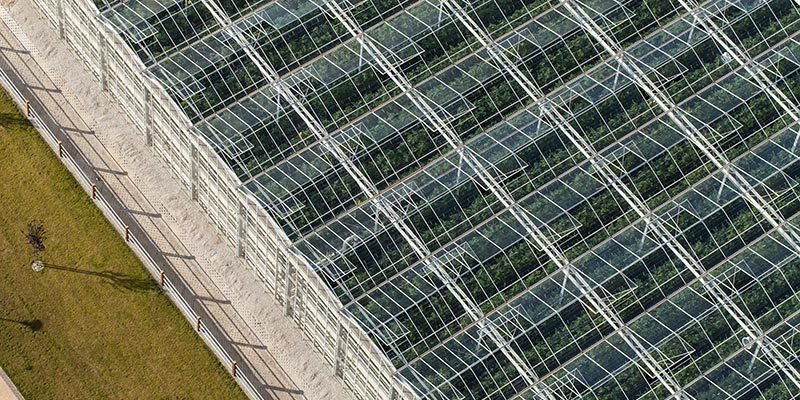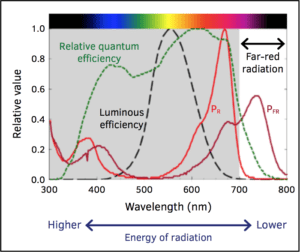
A Closer Look at Far-Red Radiation
Far-red radiation — often called far-red light — can be defined as photons with wavelengths from 700 to 800 nanometers (nm). Humans can barely see far-red radiation because it is at the edge of our eye’s visual sensitivity to light quality. Figure 1 shows the far-red waveband (to the far right) relative to the spectrum of light that controls growth and development of plants (300 to 800 nm). The luminous efficiency curve (the dashed line) represents the sensitivity of our eyes to light quality. As that curve illustrates, we perceive yellow light very well while we perceive the same quantity of blue or red light as less bright while far-red appears extremely dim.
Far-red promotes extension growth. Although we can barely see far-red radiation, it has a major effect on extension growth, meaning it influences the size of leaves, the length of stems, and ultimately the height of plants. One of the ways plants perceive light quality is through the pigment phytochrome, which exists in two different forms. One form is called the red-absorbing form (abbreviated as PR) and the other is the far-red absorbing form (abbreviated as PFR). The relative absorption of radiation by these two forms of phytochrome is also shown in Figure 1.

Because there is overlap in the absorption of PR and PFR, once plants are exposed to light, phytochrome always exists in these two forms. However, the proportion of red and far- red radiation influences how much phytochrome is in one form or the other. Plant elongation increases as the amount of far-red radiation increases relative to red light (more PFR than PR). A GPN article from 2011, The R to FR Ratio, provides more in-depth information on how red and far-red radiation influence plants.
Sunlight emits almost as much far-red radiation as red light. Leaves absorb most red light but reflect or transmit most far- red. Therefore, plants under a canopy (such as under hanging baskets) or lower leaves of plants spaced closely receive a greater proportion of far-red than red radiation. Plants perceive this filtering of light and in response, typically elongate in an attempt to capture available light. This phenomenon is called the “shade-avoidance response.”
In some situations, an elongation response is desirable but in the production of ornamentals, often it is not. There are different ways to reduce the shade-avoidance response including limiting the density of hanging baskets overhead, using wider plant spacing or supplemental lighting that emits little or no far-red, or using spectral filters that reduce transmission of far-red from the sun.
For some plants, far-red light promotes flowering. When the natural days are short, low-intensity (photoperiodic) lighting is often delivered to promote flowering of long-day plants. For some long-day plants, flowering is accelerated most when photoperiodic lighting includes both red and far-red radiation. Therefore, lamps that emit red and far-red radiation are advised, especially when crops are grown under light-limiting conditions (when the daily light integral is
Can far-red indirectly increase growth? The relative quantum efficiency curve in Figure 1 represents the effect of radiation at promoting photosynthesis on an instantaneous basis. The curve illustrates that far-red photons are weakly or not effective at promoting the photosynthetic reaction. However, as mentioned previously, far-red promotes extension growth including leaf expansion. In the absence of far-red radiation, such as when plants are raised under sole-source lighting (in growth chambers or vertical farms), leaves can be quite small. Adding far-red to the light spectrum can increase leaf size, enabling plants to capture more light and potentially increase growth. Therefore, over time, far-red radiation can indirectly increase growth. Research is being performed to determine the pros and cons of including far-red radiation in horticultural lighting.
Erik Runkle is professor and floriculture extension specialist in the department of horticulture at Michigan State University. He can be reached at runkleer@msu.edu.


 Video Library
Video Library 




















